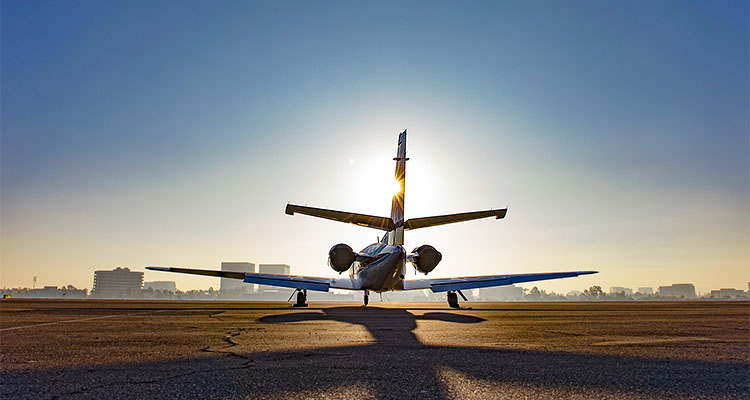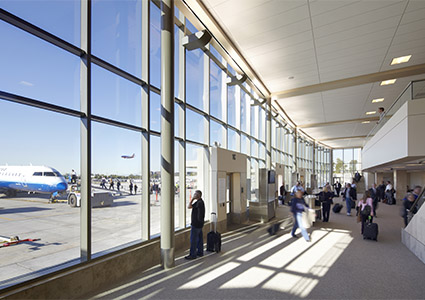
Uncover how John Wayne Airport is enhancing passenger journeys with modern amenities and sustainable practices
John Wayne Airport (JWA) is an international commercial and general aviation airport serving Orange County, California, and the Greater Los Angeles area. Owned by the County of Orange and operated as a self-supporting enterprise that receives no general fund tax revenue, the airport serves more than 11.3 million passengers annually and reaches more than 40 nonstop destinations in the United States, Canada and Mexico.
Transportation & Logistics International joins Airport Director Charlene Reynolds. She begins with some insights into its storied history: “John Wayne Airport is the only commercial airport in Orange County, and we’ve been serving this community for decades. In the 1920s, the airport began as a private landing strip built by aviation pioneer Eddie Martin, who also founded a flying school and one of the nation’s oldest aviation firms. It became Orange County Airport in 1939 through a land swap with the Irvine Company and later served as a military base during World War II before returning to county control with a commitment to support all aviation uses. The Eddie Martin Terminal opened in 1967. The current terminal, named after former Supervisor Thomas F. Riley, for his role in advancing the airport improvement project, opened in 1990, and the original terminal was demolished in 1994. 
“Currently, we’re proud to be ranked number one in customer satisfaction among large airports in the J.D. Power 2024 North America Airport Satisfaction Study. Our guests consider John Wayne Airport a convenient, clean, and trustworthy organization that is deeply connected to both the local economy and the people who live here. We’ve continued to improve in ways that are very intentional, making sure we meet demand without losing that calm, accessible feel people really enjoy when flying through JWA.”
Investing in the future
She continues with further details on the airport’s capabilities. “The airport, which spans more than 510 acres, has two runways. While that might sound small compared to some of the bigger airports, we move efficiently. The 2887-foot runway serves general aviation, and the 5700-foot main runway serves both commercial and general aviation aircraft.
“On average, we handle around 130 commercial departures a day and we’re served by 11 commercial airlines and two air cargo airlines. General aviation (private, non-commercial) aircraft represent over 60 percent of total operations. The airport includes two full-service fixed-base operators and one limited-use general aviation facility.”
As is evident from its history, JWA embraces opportunities to develop when the investment will advance airport facilities and the passenger experience. Charlene elaborates on the latest strategic investments: “We kicked off a multi-year capital improvement program in 2024. It’s really about investing in the future, making sure we modernize our infrastructure, improve the traveler journey, and stay ahead of demand. So far, we have completed the children’s play area, upgrades to our upper-level controls on the baggage handling systems and improved some back-of-house systems most guests never see but definitely benefit from. We’ll be completing the first phase of upgrading our elevators, escalators, and restroom facilities this year.
“On the horizon, we’re looking at the common use passenger processing system, a parking access revenue control systems replacement, power generation and distribution, airfield maintenance, terminal enhancements, improved curbside access, and sustainability upgrades. The goal is to keep the airport functioning smoothly, safely, and with our guests in mind every step of the way.”
Food and beverage refresh
Technology plays an important role in any improvements and upgrades. Charlene details how JWA leverages the latest solutions: “We’re always looking at options that improve efficiency and safety without overwhelming the traveler experience. Right now, we’re upgrading some of our back-end systems, like baggage handling, lighting, and general energy management, in order to be smarter and more automated. We’re not rolling out robots, but we are investing in technology and infrastructure that allows our staff and systems to work more efficiently behind the scenes and support future innovation.”
It’s not just the infrastructure side that has seen recent improvements – as Charlene reveals, some exciting developments have been made in hospitality, too. “We recently introduced several new dining options, and the response has been overwhelmingly positive. Over the past two years, we’ve opened Sambazon, a national chain serving acai bowls, Greenleaf Kitchen and Cocktails, founded in Southern California with a menu reflective of the area’s fresh, healthy vibe, and Brodard Express, a local Vietnamese eatery owned and operated by a dynamic group of minority women.
 “When we put out the initial request for proposal (RFP) for our concessions program refresh, we looked for a mix of national brands and local favorites because our passengers want comfort and quality, as well as a little taste of Orange County. Over the next three to five years, a variety of new concessions and retail stores will be opening, including Wahoo’s Fish Taco and Sgt. Pepperoni’s Pizza, both locally founded, Dunkin’, Earl of Sandwich, and Brookstone, among others. Once complete, we will have refreshed over 83 percent of our concessions program.
“When we put out the initial request for proposal (RFP) for our concessions program refresh, we looked for a mix of national brands and local favorites because our passengers want comfort and quality, as well as a little taste of Orange County. Over the next three to five years, a variety of new concessions and retail stores will be opening, including Wahoo’s Fish Taco and Sgt. Pepperoni’s Pizza, both locally founded, Dunkin’, Earl of Sandwich, and Brookstone, among others. Once complete, we will have refreshed over 83 percent of our concessions program.
“These concessions typically operate on long-term, multi-year contracts, but we’re always reviewing feedback and keeping things fresh where we can. The goal is to offer something for everyone, whether you’re grabbing a quick coffee or sitting down for a meal before your flight.”
Community commitment
JWA’s dedication to promoting Orange County is clear from its approach to dining options, and as Charlene goes on to explain, community outreach is also a huge priority. “Beyond our capital improvement efforts, we’ve been focused on supporting several community-focused programs that really reflect our values as a good neighbor,” she says.
“Our arts program, for example, continues to bring diversity and culture into the terminal through rotating exhibits and live performances, offering guests a unique perspective of the area through the eyes of local artists. We’ve also launched a food donation program in partnership with our concessions to collect unsold, quality food and redirect it to local nonprofit organizations. This reduces waste while supporting food-insecure individuals in Orange County.
“We’re proud of the continued momentum behind our Fly Friendly program, which encourages general aviation jet operators to reduce noise and emissions through voluntary best practices. Finally, our JWA Air Academy has been a great success in educating community members who want to understand how an airport operates. From security to sustainability, we provide learning opportunities and behind-the-scenes experiences for participants.
“We’re here to serve the public, and we take that responsibility seriously. All these programs help us connect with the public in meaningful ways while advancing responsible operations.”
This strategy is also evident across the airport’s operations. Charlene highlights JWA’s sustainability efforts as an example: “We take a practical, layered approach to sustainability. That includes everything from LED lighting and low-flow water systems to investing in electric ground support equipment and offering charging stations for electric vehicles.
“As mentioned, our Fly Friendly program encourages general aviation jets to reduce noise and emissions, and this is championed by Vice Chair Katrina Foley, Board of Supervisors, Fifth District. Additionally, we’ve partnered with local organizations on ecological restoration efforts as well. It’s all about making choices that help us operate responsibly long-term.”
Superior customer experience
Charlene then concludes by sharing JWA’s ambitions for the remainder of the year and beyond: “We’re focused on continuing our capital improvement work while maintaining superior customer service and guest experience. We also want to grow our community engagement efforts, especially with local organizations in the general community and within the aviation industry. Of course, we’re always looking for ways to make travel through JWA even smoother and more enjoyable.
“Further afield, in five years, I’d like to see JWA known not just as a convenient alternative to larger airports but as a national example of how to deliver a high-quality, community-focused travel experience. I want us to invest in the airport’s future and continue improving infrastructure, adding destinations, and embracing sustainability while staying true to our mission, vision, and values.”